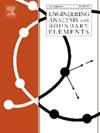用节点残差下降法求解静电和电弹性问题
IF 4.2
2区 工程技术
Q1 ENGINEERING, MULTIDISCIPLINARY
Engineering Analysis with Boundary Elements
Pub Date : 2025-01-01
DOI:10.1016/j.enganabound.2024.106053
引用次数: 0
摘要
压电材料在工程中广泛应用于传感器、换能器和致动器的制造。由于极化方向的耦合性、各向异性和任意性,数值计算中涉及的网格生成、数值积分和全局方程的构建等任务复杂而非平凡。为了解决静电和电弹性问题,本文建立了一种易于实现的节点残差下降法。通过对三维静电、线弹性和电弹性问题的求解,验证了NRDM的能力和精度,应力的相对误差为0.17% ~ 1.60%,其他变量的相对误差为0.02% ~ 0.15%。基本变量和高阶变量具有二阶精度,使用一阶广义有限差分格式的收敛率范围为1.98至2.27。这全面验证了双重求导技术。在迭代过程中,基于压电本构方程的应力-电荷形式,通过显式计算电位移和应力,可以解决电弹性耦合问题。此外,将局部基坐标技术无缝集成,可以通过显式张量运算求解任意极化方向的各向异性压电问题。本文章由计算机程序翻译,如有差异,请以英文原文为准。
Solving electrostatic and electroelastic problems with the node's residual descent method
Piezoelectric materials are extensively used in engineering for the fabrication of sensors, transducers, and actuators. Due to the coupling characteristics, anisotropy, and arbitrariness of polarization directions, the tasks of mesh generation, numerical integration, and global equation formulation involved in numerical computations are complex and nontrivial. To solve electrostatic and electroelastic problems, an easily implementable node's residual descent method (NRDM) is established in this study. The capability and accuracy of NRDM are validated through the solution of three-dimensional electrostatic, linear elastic, and electroelastic problems, achieving relative errors of 0.17%–1.60% for stress and 0.02%–0.15% for other variables. Fundamental and higher-order variables exhibit second-order accuracy, with convergence rates ranging from 1.98 to 2.27 using a first-order generalized finite difference scheme. This comprehensively validates the double derivation technique. The electroelastic coupling problems can be addressed by explicitly calculating electric displacement and stress based on the stress–charge form of piezoelectric constitutive equations during the iteration process. Additionally, the local basis coordinate technique is seamlessly integrated, enabling the solution of anisotropic piezoelectric problems with arbitrary polarization directions through explicit tensor operations.
求助全文
通过发布文献求助,成功后即可免费获取论文全文。
去求助
来源期刊

Engineering Analysis with Boundary Elements
工程技术-工程:综合
CiteScore
5.50
自引率
18.20%
发文量
368
审稿时长
56 days
期刊介绍:
This journal is specifically dedicated to the dissemination of the latest developments of new engineering analysis techniques using boundary elements and other mesh reduction methods.
Boundary element (BEM) and mesh reduction methods (MRM) are very active areas of research with the techniques being applied to solve increasingly complex problems. The journal stresses the importance of these applications as well as their computational aspects, reliability and robustness.
The main criteria for publication will be the originality of the work being reported, its potential usefulness and applications of the methods to new fields.
In addition to regular issues, the journal publishes a series of special issues dealing with specific areas of current research.
The journal has, for many years, provided a channel of communication between academics and industrial researchers working in mesh reduction methods
Fields Covered:
• Boundary Element Methods (BEM)
• Mesh Reduction Methods (MRM)
• Meshless Methods
• Integral Equations
• Applications of BEM/MRM in Engineering
• Numerical Methods related to BEM/MRM
• Computational Techniques
• Combination of Different Methods
• Advanced Formulations.
 求助内容:
求助内容: 应助结果提醒方式:
应助结果提醒方式:


